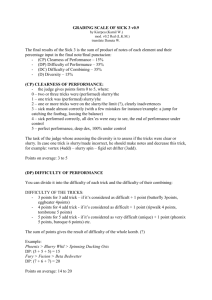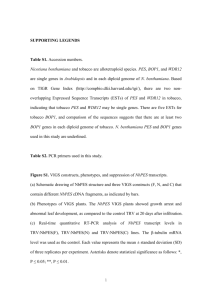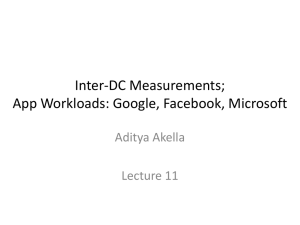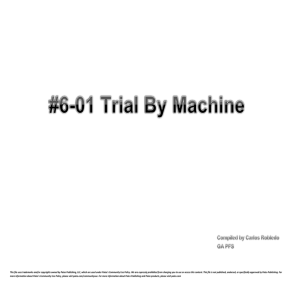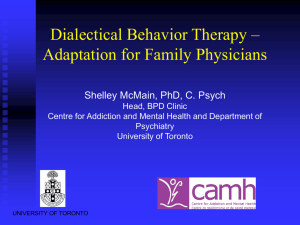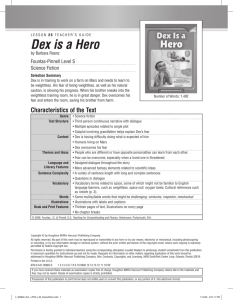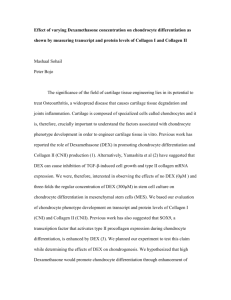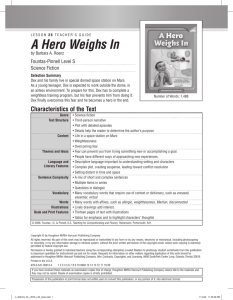BPD and Steroids - Christiana Care Health System
advertisement
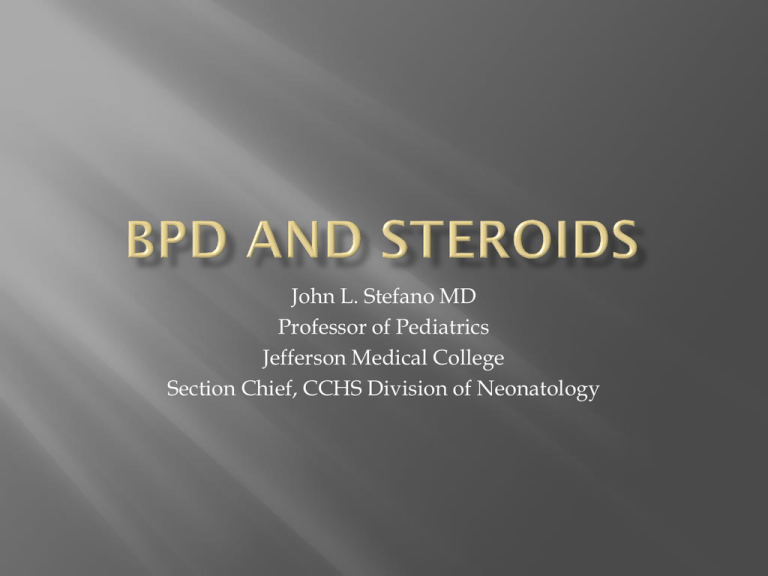
John L. Stefano MD Professor of Pediatrics Jefferson Medical College Section Chief, CCHS Division of Neonatology Northway definition: Radiographic History of RDS, PPV x 3d, radiographic changes plus Oxygen dependency at 28 days PNA (Bancalari 1979)or... History of RDS, radiographic changes plus Oxygen dependency at 36 weeks PCA (Shennen 1988) Physiologic Test for Diagnosis of BPD Infants at 35 to 37 weeks PMA receiving mechanical ventilation, continuous positive airway pressure, or >30% O2 with saturation of <96% have BPD Infants receiving <30% O2 or 30% O2 with saturation of >96% tested for O2 need —O2 progressively decreased gradually to room air —No BPD if saturation is >90% in room air for 30 min Hallmark- Arrest in lung development Hazy lungs, minimal cystic changes Persistent O2 requirement that slowly resolves Less airway reactivity Less pulmonary hypertension Problem: Incidence/Frequency data depend on which definition is used to comprise the numerator (eg 28d O2 vs O2 at 36 wks PCA, physiologic definition) Problem: Incidence/Frequency data depend on patient population comprising the denominator (eg NICU admissions/survivors, ventilated infants, surfactant treated infants, ELBW etc) B irth W eight % O 2 @ 28d P N A (range) % O 2 @ 36w ks P C A (no. pts) 501-750g 79% (67% -100% ) 42% (21% -68% ) 13% (5% -23% ) 26% (13% -38% ) 26.3% (31/118) 13.1% (33/252) 4.5% (42/933) 8.1% (106/1303) 751-1001g 1001-1500 A ll Since 1980, the incidence of BPD has increased or decreased depending on the data reported Increased incidence-Parker et al, 1992: 1976-1980---10.6% 1981-1985---21.7% 1986-1990---32.9% However, 72% of this increase was attributed to increased survival Using “Physiologic test for BPD” NICHD – 2004 17 NICU’s in NICHD network. Incidence decreased from decreased from 35% to 25% of infants with birth weights < 1250 grams Prenatal Early Post Natal Late Post Natal NIH Concensus Statement 1995 Reduction in RDS ~ 50% reduction Reduction in mortality~ 60% reduction Reduction in IVH~ 50% reduction Extrapolate that RDS reduction will result in a lower BPD rate however no published data Many questions, few answers Timing of steroids: early vs. late Route: systemic vs. inhaled Dosing, duration of therapy, pulse vs. daily Tapering; rebound Side effects Study A ge/ D uration G roup N o. IM V O2 LOS duration duration >14d for >30d tx >30d for > 14d tx >14d 18d or 42d tx K azzi et al 21-28d 1990 17d tx C ollaborat. ~21d D ex T rial 7d tx 1991 9d optional O hlsson et 21-35d al 1992 9d tx B rozanski et 7d al 1995 3d q 10d Pl D ex Pl D ex Pl D ex 18 D ex 42 Pl D ex/H C 8 8 12 9 11 12 13 11 12 0/7 E xt 7/7 E xt* 57.2d 39.4d* 84d 73d 29d* 3/11 E xt 8/12 E xt* Pl D ex Pl D ex Pl D ex 142 143 13 12 39 39 D urand et al 7-14d 1995 7d tx Pl D ex 20 23 A very et al 1985 H arkavy et al 1989 C um m ings et al 1989 95.5d 74.9d 136d 190d 65d** 75d 79d O 2>60d 17.5d 38% 11d * 33% 2/13 E xt 8/12 E xt* 74d 209d 49d 150d * O 2@ 28d 35d 68% 20d * 32% * 62d 86d 119d 111d 76d 87d >100d 27% 22% 140d 115d 85d 69d * Study Age/ Duration Group No. IMV Duration Yeh et al Dex 1990 1mg/k/dx3d Pl taper x12d Dex Sanders Dex et al 1994 .5mg/k q 12h for 1 day Suske et Dex al 1996 .5 mg/k/d x 5d Shinwell Dex et al 1996 .25mg/k q12 x3d Pl Dex Dex 29 28 Ext @2wk 28% 57% * 32d 27d 21 19 47d 35d 73d 44d Pl Dex 12 14 14.2d 6.6d * 12.5d 4.1d * Pl Dex 116 132 11d 9d 19d 20d 34 36 23.4d 8.4d 42.2d 12.2d * Rastogi Dex et al 1996 .5mg/k/d Pl taper x 12d Dex Tapia et O2 O2@ Duration ???? O2>40 % 20d 8d no BPD 43% 68% O2>28d 25% 7% O2>40 % 10d 8d O2>40 % 10.5d 1.5d * O2>36w Hyperglycemia Immune suppression & sepsis Hypertension Hypertrophic cardiomyopathy Leukocytosis Azotemia (catabolic state) Poor growth (brain, lung, osteopenia) Adrenal suppression Gastric Perforation (especially if used with Indocin) Animal studies have shown negative effects on cell growth (brain and lung) Cummings et al 1989: better Bayley scores in the 42d treated group (low n; low rate of IVH in study group) Sobel et al 1992: Dex>24d less cryotherapy for ROP In the mid-90’s long term studies start to show concern for N/D outcome and/or brain growth O’Shea TM et al 1993:no difference in growth, CP or Bayley scores Jones R et al 1995: Multi-centered European Study; no difference in growth, CP, special schooling needs NICHD 1996; early vs late Dex; decreased growth parameters, especially HC in early Dex. NICHD 2001; early Dex vs. placebo; less likely to be O2 dependent at 28 days but lower weight gain and smaller HC. Vermont Oxford Network: (Pediatrics 2001) Early Dex. No decrease in BPD or death, had fewer days in supplemental O2, increase risk of GI perforation, decrease weight gain, trend to have more PVL AAP statement on Steroid use to treat or prevent BPD-suggested moratorium on all postnatal steroid use for BPD The statement included a moratorium on the use of inhaled steroids as well If considering use of steroids strongly recommended informed parental consent. Wrong steroid?? Why Dexamethasone? Dex. Has sulfites in preservative---CNS toxin Wrong dose of Dex.??- most studies used 0.5mg/kg/day and then taper. Dose 10x that needed to saturate receptors. Length of therapy?? Rebound? When to start (early, late, really late) Early Late Early Late Hydrocortisone as an alternative to Dex. Watterberg et al (Pediatrics 2004) Early prophylaxis with low dose HC; no difference in BPD except infants with h/o of chorioamnionitis; HC and Indocin together— gastrointestinal perforations (largest study: n=360) However, other smaller studies show favorable effect of low dose hydrocortisone Less side effects than systemic steroids Problems with delivery of medication to distal airways: Arnon et al 1992 only .02% of dose with nebulizer 14.2% of dose with metered inhaler Only a few small studies (n=13-20 infants) short term improvement in PFT’s, possibly enhance early extubation; virtually no side effects Cochrane review: inhaled versus systemic corticosteroids 2003 The review found no evidence that inhaled corticosteroids confer net advantages over systemic corticosteroids in the management of ventilator dependent preterm infants. Neither inhaled steroids, nor systemic steroids, can be recommended as standard treatment for ventilated preterm infants. There was no evidence of difference in effectiveness or side-effect profiles for inhaled versus systemic steroids. A better delivery system guaranteeing selective delivery of inhaled steroids to the alveoli might result in beneficial clinical effects without increasing sideeffects. Dexamethasone Hydrocortisone High dose-do not recommend Low dose-may facilitate extubation and reduce short and long term issues seen with high dose Dex Early hydrocortisone treatment may be beneficial in a specific population of infants. Inhaled Corticosteroids No efficacy. No change from previous statement Relative Protein Binding Half-life Plasma (%) (min) 0.8 1 90 90 30 90 5 0 — 180 4 0.8 90-95 200 4 0.8 70 60 5 0 — 300 25 0 64 100-300 25-30 0 — 100-300 Mineralocorticoids 10 125 42 200 Approximate Equivalent Dose (mg) Routes of Administration Cortisone Hydrocortisone 25 20 P.O., I.M. I.M., I.V. Short-Acting 0.8 1 Intermediate-Acting MethylPREDNISo lone1 4 P.O., I.M., I.V. Glucocorticoid PrednisoLONE 5 PredniSONE 5 Triamcinolone1 4 Relative Mineralocorticoid Anti-inflammatory Potency Potency P.O., I.M., I.V., intra-articular, intradermal, soft tissue injection P.O. I.M., intra-articular, intradermal, intrasynovial, soft tissue injection Long-Acting Betamethasone 0.75 Dexamethasone 0.75 Fludrocortisone — P.O., I.M., intraarticular, intradermal, intrasynovial, soft tissue injection P.O., I.M., I.V., intra-articular, intradermal, soft tissue injection P.O. Early: 2-3 weeks post-natal with evolving BPD, ventilated and requiring > 80% FiO2 Consider Hydrocortisone starting dose of 5 mg/kg/day No clinical response – decrease in respiratory support – after second or third day, discontinue Positive clinical response treat for 24-48 hours then taper over a period of 7-10 days Late: 36 weeks PCA with BPD/CLD, FiO2 35-40% or greater and continued need for ventilation ; X-ray changes of BPD DART treatment – Decadron Start Decadron 0.15 mg/kg/day 10 day course - Wean over 10 days +/- Prednisone if rebound (???)
